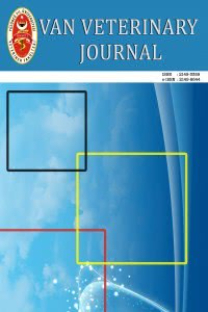Kedilerde süksinilkolin ve pankuronyumun hematolojik biyokimyasal ve kas gevşetici etkilerinin karşılaştırılması
Bu çalışmada, 20 adet Süksinilkolin grubu, 20 adet de pankuronyum grubu için olmak üzere toplam 40 adet sokak kedisi kullanıldı. Süksinilkolin 1,5 ve l mg/kg'lık dozlarda, pankuronyum ise 0,2 ve 0,1 mg/kg'lık dozlarda kullanıldı. Bu ilaçların etki başlama ve etki süreleri ile uygulama öncesi, 15. dakikası ve sonrası kalp atım sayıları, vücut ışılan, oksijen saturasyonu, $pCO_2 ve HCO_3$ değerlerine bakıldı. Her iki grupta da oksijen saturasyon değerlerinde hafif artış gözlendi(p
Anahtar Kelimeler:
kas gevşeticiler, biyokimya, ağrı kesiciler, hematoloji, kedi, süksamethonyum, anestetikler, karşılaştırmalar
The comparison of effects hematological, biochemical and myorelaxation of succinylcholine and pancuronium in cats
In this study, 20 cats for Succinylcholine group, 20 cats for Pancuronium group totally 40 dogs were used. Succinylcholine was used at the dose of 1.5 and 1 mg/kg; Pancuronium was used at the dose of 0.2 and 0.1 mg/kg. Heart rate, body temperature, oxygen saturation, $pCO_2 and HCO_3$ of the dogs were assessed at the onset time effect and duration of drugs, before treatment, at the 15 min. and after using TOFF GUARD device. In both group, a slight increase on oxygen saturation were recorded (p<0.05). $HCO_ 3$ body temperature and $pCO_2$ values decreased slightly. In the Succinylcholine group; heart rate slightly increased (p<0.05) when high dose was used. In the Pancuronium group heart rate unchanged when either low or high dose were used. In conclusion, when short time intubation is needed Succinylcholine could be used but when long time myorelaxation is needed, Pancuronium could be used safely.
Keywords:
muscle relaxants, biochemistry, analgesics, haematology, cats, suxamethonium, anaesthetics, comparisons,
- ISSN: 1017-8422
- Yayın Aralığı: Yılda 3 Sayı
- Başlangıç: 1990
- Yayıncı: Yüzüncü Yıl Üniv. Veteriner Fak.
Sayıdaki Diğer Makaleler
M. Yavuz GÜLBAHAR, MEHMET ÇABALAR, A. ERTÜRK
Serum, plasma and erythrocyte zinc levels in various animal species
FATMAGÜL YUR, Ayşegül BİLDİK, FERDA BELGE, DİDE KILIÇALP KILINÇ
Ceylanpınar Tarım İşletmesi' nde yetiştirilen ivesi koyunlarınınsüt verimi ve laktasyon süresi
Musa GENÇCELEP, ABUZER TAŞ, NAZMİ ATASOY, Hanefi ÖZBEK, M. Enes ALTUĞ, LOĞMAN ASLAN
Evaluation of nutritive value of forages grown around Van Lake
Mehmet Akif KARSLI, NİHAT DENEK, Suphi DENİZ, Akif GÜNDÜZ
Van ilinde tüketime sunulan kıymalarda hereketli Aeromonas türlerinin varlığı ve yaygınlığı
